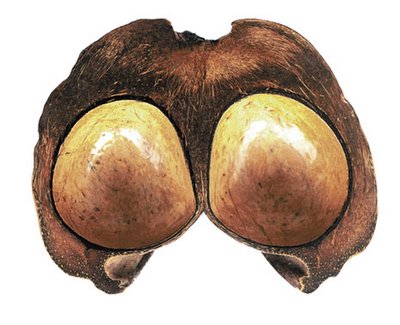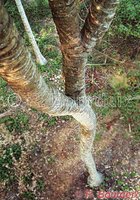
By Dr Roland Bourdeix. Click on the pictures to enlarge them...
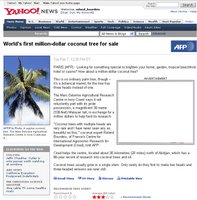
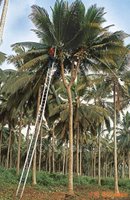 |
Dr Roland Bourdeix climbing
the Three head palm |
The Three Heads palm is a rare botanical curiosity. It amounts to just one case, reported on a plantation of approximatively 1,000 hectares, (i.e. 150,000 palms) of a coconut tree whose stem has branched on two occasions.
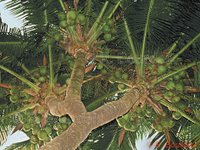
Usually, the coconut palm only has a single terminal bud which emits all the organs: bunches, fronds and stem. This single bud, which is well protected, functions continually in a system of vertical spirals. In general, 12 to 18 fronds and inflorescences are produced each year. Over the same period, the coconut palm produces from 20 to 160 cm of stem, depending on the age and variety. therefore a coconut palm will never stop growing, until it dies.
It is very rare to find coconut palms with several leaf crowns. Such abnormalities are usually caused by boring insect attacks, or by large branches falling off and damaging the terminal bud of the coconut palm. In a few rare cases, the damaged bud is not totally destroyed, but its growth is disrupted. This sometimes leads to stem branching. In the case of the Malayan Tall Three Heads, there is no scarring indicating insect attacks, or an accident that might have disrupted the bud and caused branching. Moreover, this branching has occurred twice and at least a full year apart.
It is likely that the cause of branching was accidental, even though signs of the accident are not visible. However, the fact that the coconut palm has branched twice indicates that this palm possesses a genetic predisposition to branching.
The Malayan Tall Three Heads is a botanical curiosity of which there is only one example in Africa. Coconut palms of this type may be of interest to botanical gardens or tourist sites.
So, this palm was for sale at the amazing price of USD 1 000,000 (one million dollars only). This money may help African research on the coconut palm to go further… Wa found a customer in Florida, the owner of a large luxury resort, but finally the Ivoirian Government refused to sell. It has been decided to harvest seednuts from the three heads and raise them in the research centre nursery. However, nobody knows whether the extraordinary characteristic of the parent will pass onto its progenies. Call back in 20 years to get the answer !

